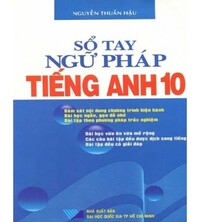Tiếng Anh 10 Unit 8 Listening
1. Work in pairs. Tick (✓) what you often do to prepare before a new lesson. 2. Listen to the first part of the conversation between a teacher and her students, then answer the following questions. 3. Listen to the second part of the conversation and complete the flow chart with no more than TWO words. 4. Work in groups. Discuss the questions.
Bài 1
Blended learning
1. Work in pairs. Tick (✓) what you often do to prepare before a new lesson.
(Làm việc theo cặp. Đánh dấu (✓) những việc bạn thường làm để chuẩn bị trước bài học mới.)
|
Read materials for the new lesson (textbooks) |
|
|
Watch videos related to the lesson |
|
|
Search information related to the new lesson |
|
|
Review old lessons |
Lời giải chi tiết:
|
✓ |
Read materials for the new lesson (textbooks) (Đọc tài liệu cho bài mới (SGK) |
|
Watch videos related to the lesson (Xem các video liên quan đến bài) |
|
|
✓ |
Search information related to the new lesson (Tìm kiếm thông tin liên quan đến bài mới) |
|
✓ |
Review old lessons (Ôn bài cũ) |
Bài 2
2. Listen to the first part of the conversation between a teacher and her students, then answer the following questions.
(Nghe phần đầu tiên của cuộc trò chuyện giữa một giáo viên và học sinh của cô ấy, sau đó trả lời các câu hỏi sau.)
1. What is the teacher talking about?
2. What has she uploaded on Eclass?
Phương pháp giải:
Bài nghe:
Teacher: Now, listen everybody! I'd like you all to complete this population map at home. Do you have any questions for this week's homework?
Nam: Do we need to read the materials and watch the videos that you've uploaded on Eclass for the next lesson?
Teacher: Yes, Nam ...
Tạm dịch:
Cô giáo: Bây giờ thì lắng nghe nào các em! Cô mong rằng các em sẽ hoàn thành bẩn đồ dân số ở nhà. Các em có câu hỏi nào cho bài tập về nhà tuần này không nhỉ?
Nam : Thưa cô chúng em có cần đọc tài liệu và xem những video cô đã đăng trên Eclass cho buổi học tiếp theo không ạ?
Cô giáo: Có Nam ạ...
Lời giải chi tiết:
1. What is the teacher talking about? (Cô giáo đang nói về điều gì?)
- The teacher is talking about things students need to do at home and how to prepare for the next lesson.
(Cô giáo đang nói về những điều học sinh cần làm ở nhà và csachs chuẩn bị cho bài học tiếp theo.)
2. What has she uploaded on Eclass? (Cô đã đăng những gì trên Eclass?)
- She uploaded materials and videos.
(Cô ấy đã đăng tài liệu và các video.)
Bài 3
3. Listen to the second part of the conversation and complete the flow chart with no more than TWO words.
(Nghe phần thứ hai của cuộc trò chuyện và hoàn thành sơ đồ với không quá HAI từ.)
Phương pháp giải:
Bài nghe:
Teacher: To prepare for next week's class, you should log in to your account on Eclass and click the Homework folder. I've uploaded some reading passages, slides and two videos about population growth. Read the materials, watch the videos and take notes of important points at home.
Mai: Can we use a mindmap to present the main ideas?
Teacher: Yes, you can, Mai. Choose a suitable way for you. Next week we'll discuss the impact of population growth on the environment so I want you to find more information on this topic.
Mai: Where can we get the information?
Teacher: You can go to the library, read newspaper articles or search the Internet for information. Work in groups of four, discuss and write down what you've discovered. Email me if you have any questions...
Tạm dịch:
Giáo viên: Để chuẩn bị cho tiết học tuần sau, các em nên đăng nhập vào tài khoản của mình trên Eclass và nhấp vào thư mục Bài tập về nhà. Cô đã tải lên một số bài đọc, slides và hai video về sự gia tăng dân số. Các em đọc tài liệu, xem video và ghi chú những điểm quan trọng ở nhà.
Mai: Thưa cô chúng em có thể sử dụng sơ đồ tư duy để trình bày những ý chính không ạ?
Cô giáo: Có Mai ạ. Hãy chọn cách phù hợp với các em. Tuần tới, chúng ta sẽ thảo luận về tác động của gia tăng dân số đến môi trường, vì vậy cô muốn các em tìm thêm thông tin về chủ đề này.
Mai: Chúng em có thể lấy thông tin ở đâu ạ?
Giáo viên: Các em có thể đến thư viện, đọc các bài báo hoặc tìm kiếm thông tin trên Internet. Làm việc theo nhóm bốn người, thảo luận và ghi lại những gì các em tìm được. Hãy gửi email cho cô nếu các em có bất kì câu hỏi nào…
Lời giải chi tiết:
|
1. Homework |
2. take notes |
3. information |
4. discuss |
5. Email |
Log in to your account on Eclass anfd click the (1) Homework folder.
(Đăng nhập vào tài khoản của các em trên Eclass và nhấp vào thư mục Bài tập về nhà.)
Read the materials, watch the vdeos and (2) take notes of the main ideas.
(Đọc tài liệu, xem video và ghi chép lại những ý chính.)
Go to the library, read newpaper articles or search the Internet to find (3) information.
(Đến thư viện, đọc các bài báo hoặc tìm kiếm trên mạng Internet để tìm thông tin.)
Work in group, (4) discuss and write down your research results.
(Làm việc theo nhóm, thảo luận và ghi lại kết quả thu được.)
(5) Email the teacher if you have any questions.
(Gửi email cho giáo viên nếu có bất kì câu hỏi nào.)
Bài 4
4. Work in groups. Discuss the questions.
(Làm việc nhóm. Thảo luận các câu hỏi.)
Which is more effective: blended or traditional learning? Why?
(Cách nào hiệu quả hơn: học tập kết hợp hay học truyền thống? Vì sao?)
Lời giải chi tiết:
From my point of view, blended learning is more effective than traditional learning. The main reason is that students can focus on content like new vocabulary or pronunciations while using their self-paced, online material on their own time. In live sessions, the teacher can work with students to support their unique needs and goals. No class time is wasted covering material students already know or that they can practice on their own. Learning is maximized with more effective and authentic learning time in each environment.
(Theo quan điểm của tôi, học tập kết hợp hiệu quả hơn cách học truyền thống. Lý do chính là học sinh có thể tập trung vào nội dung bài học như từ vựng hoặc cách phát âm mới trong khi sử dụng tài liệu trực tuyến theo nhịp độ học của riêng họ. Trong các buổi học trực tiếp, giáo viên có thể làm việc với học sinh để hỗ trợ các nhu cầu và mục tiêu riêng của họ. Không cần lãng phí thời gian dạy lại các nội dung mà học sinh đã biết hoặc họ có thể tự thực hành. Việc học tập được tối đa hóa với thời gian học tập hiệu quả và đích thực hơn trong từng môi trường.)
Search google: "từ khóa + timdapan.com" Ví dụ: "Tiếng Anh 10 Unit 8 Listening timdapan.com"







